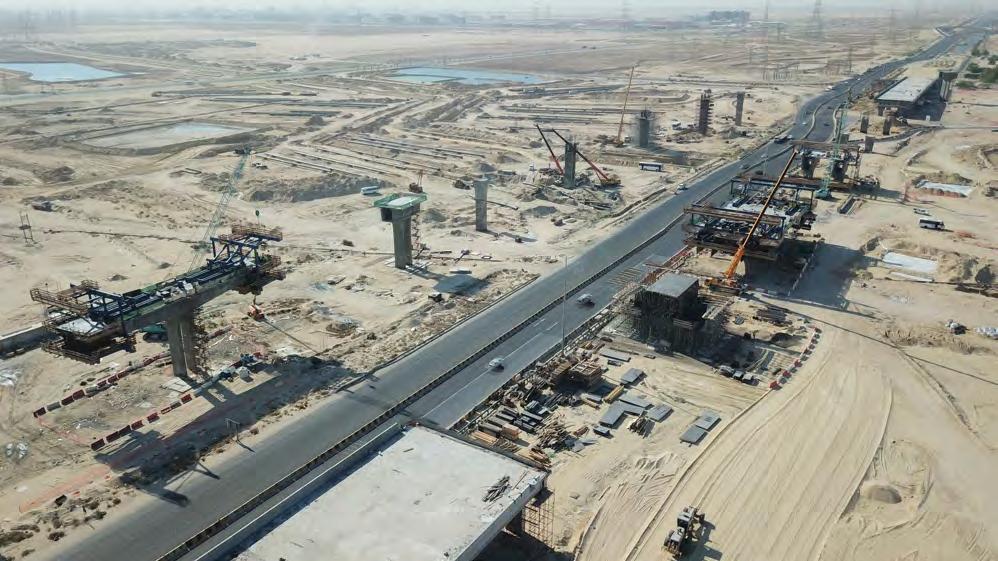
17 minute read
Kuwait’s first in-situ cantilever bridge
An all-in-one formwork solution was provided for the project.
Nawaseeb Road is an important element of Kuwait's transport infrastructure. The bridge project is a special case for two reasons: Not only is it currently Kuwait's first cantilever bridge project, but it is also the first time a bridge is cast in-situ.
The Nawaseeb Road in Kuwait forms an important part of the country’s national infrastructure, providing a strategic, logistical corridor to neighbouring Saudi Arabia. In delivering a solution for the highway bridge section, Doka has helped provide Kuwait with a landmark achievement - its first, in-situ cantilever bridge. Doka is a world leader in providing innovative formwork, solutions and services in all areas of construction. The company supplied an all-in-one solution, which included 3D planning, Cantilever Forming Travellers (CFTs), and formwork instructors’ support to ensure a smooth, fast and cost-effective process. Section RA217 of Nawaseeb Road, also known as Route 40, is one of Kuwait's most important infrastructure and transport projects and is part of the Kuwait Development Plan 2015-2020. Covering a stretch of 37 km, the development includes the reconstruction and expansion of the highway into a six-lane dual carriageway (three in each direction) with nine interchanges and three bridges, with the ultimate aim of improving access and safety on the roads, by eliminating U-turns and replacing them with roundabouts at all interchanges. Doka was required to find a casting solution for the two main bridges, including pier-to-pier spans, which at their longest measures 110 m each and has a total combined length of 940 m, as well as one ramp bridge with a maximum span of 95 m between piers and measuring 893 m in length. A total of 300 casting sections, weighing up to 250 tons, were required for the project.
All-in-one solution
Doka used its internal, digital planning tools to design the right solution for the project, which included detailed designs that helped accelerate the planning process, while providing the client with an overall visual representation of the project. In addition, a 3D model was developed with DokaCAD for Revit to give more precise visualisation of the CFT system. In total, six Doka CFTs, supplemented with approximately 2,000 m² of Large-area formwork Top 50 were used on both the main bridges and ramp bridge at Interchange

The Doka Cantilever Forming Traveller offers formwork and shoring from a single source. The ideal balance between support structure and formwork enables the construction of 470 m of the main bridge.
five. In total, approximately 825 tons of Doka material were used during this process. Using 3D modelling techniques, Doka provided an accurate rendering of the CFT in action, prior to erection on site.
Minimal parts kept erection times to a minimum
Using Doka’s CFT, the client was reassured by its precision and how its modular components enabled it to adapt flexibly and quickly to the bridges’ varying geometrics. Thanks to the system's ergonomics and a small number of separate parts, the construction process was optimised, meaning a shorter construction schedule and reduced cost.
Adjustments made easy with hydraulic cylinder
Due to the limited space available on-site, hydraulic cylinders were used to strip the inner wall formwork. As the bridge deck geometry was required to be reduced at every casting step, as part of the agreed planning process, the formwork and components of the CFT had to be continuously adjusted. Various hydraulic cylinders and other integrated functions allowed for an easy adjustment process without using chain hoists or additional workforce.
Safety first through slide bearings
The CFT uses special slide bearings to allow safe and controllable shunting while preventing unwanted movement along its longitudinal gradients. Thanks to this feature, the construction team’s safety was ensured in every phase of the project through fully-enclosed working platforms and an integrated ladder system at all levels.
Formwork for pier heads and temporary supporting towers
Doka also provided the formwork for the pier heads, which measured up to 20 m in height, 12 m in length, and was erected onto Load-bearing towers d3 with Largearea formwork Top 50.
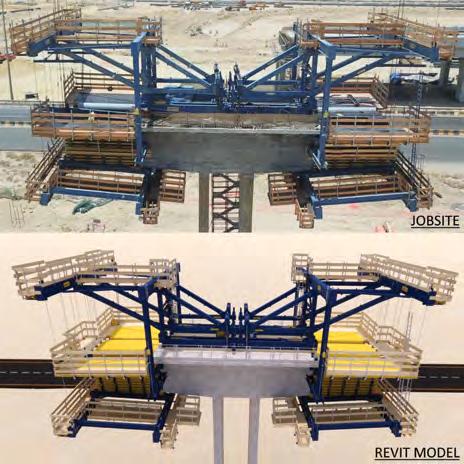
Using 3D modelling techniques, Doka provided an accurate rendering of the CFT in action, prior to erection on site. Due to the restrictions imposed by existing gas pipelines, the piers’ location was pre-defined, resulting in different spans, which led to an imbalance in construction delivery. To support the bridge deck during this phase, Doka UniKit towers were used to safely transfer up to a maximum force of 3,800 kN, to restore balance to the process and ensure the safe delivery of the piers. Doka Formwork Instructors supported on-site delivery by ensuring that the formwork was used effectively and that the operations ran smoothly from start to finish.
All images by Doka
PROJECT DATA Project
RA217 Nawaseeb Road
Location
Kuwait City, Kuwait
Building type
In-situ concrete bridge project using the cantilever method
Length of the main bridge
470 m
Span of the main bridge
110 m
Number of casting steps
84
Length of the ramp bridge
893 m
Span of the ramp bridge
95 m
Number of casting steps
132
Client
Ministry of Public Works (MPW)
Main Contractor
Freysinnet
Start of formwork operation
January 2020
End of formwork operation
February 2021
Contribution by Doka Products provided
Cantilever Formwork Travellers (CFTs) Large-area formwork Top 50 Load-bearing tower d3 Load-bearing system Doka UniKit
Services provided
3D planning with DokaCAD for Revit Technical project support Formwork instructors
FULLY REDESIGNED
MRT ROTATING TELEHANDLERS FROM MANITOU
To bring clarity to its range of rotating telehandlers, the Manitou Group has decided to give its two ranges new names - VISION and VISION+. Also, two new machines, the MRT 1645 and MRT 1845 models, have been added to the VISION range. With 500 kg (1,100 lbs) of additional load capacity compared to their predecessors, these two products offer a lifting height of 16 m (52 ft 5 in) and 18 m (59 ft 1 in), respectively, for a load of 4.5 tons (9,900 lbs). They are also equipped with a new Stage V engine, producing power of 75 hp and 116 hp, respectively. The VISION range offers a wide selection of 14 models with heights ranging from 16 m (52 ft 5 in) to 25 m (82 ft), for a load capacity of up to 4.5 tons (9,900 lbs). The highest capacities are grouped together in the VISION+ range, which features 12 new models. The range has been completely revamped with six new products - MRT 2260, MRT 2660, MRT 3570 (also available in an electronic suspension version), MRT 2570 and MRT 3060. This high-capacity equipment range meets the requirements of customers who want higher performance on construction sites. With models offering a lifting height of 22 m (72 ft 9 in) to 35 m (114 ft 8 in) and a much improved capacity of up to 7 tons (15,400 lbs), this range is ideal for the installation of structural steelwork, renovation of buildings and even demolition. These two ranges are connected as standard, in order to optimise maintenance, increase the machine's operating hours and therefore reduce the total cost of ownership for the user. The VISION and VISION+ ranges are now available worldwide and will be delivered to the dealer network, to rentals and to key accounts by September 2021.
MRT-specific attachments
New attachments, designed by the Manitou Attachment Competence Center (ACC) based in Italy, accompany the launch of these two ranges. Two CAF 1030 (6 tons / 13,200 lbs and 7 tons / 15,400 lbs) and CAF 1080 (7 tons / 15,400 lbs) floating fork carriages will benefit users who need to handle pallets or big-bags with optimum visibility. They are lighter and more robust, and are fitted with a fork locking system. The performance of winches, jibs and cranes is enhanced with a winch equipped with a new hydraulic motor suited to the new MRTs. With a capacity ranging from 600 kg (1,300 lbs) to 2 tons (4,400 lbs), they meet the requirements of the new MRT range. A new 100% aluminum platform is now available across the whole VISION+ range. Weighing just 180 kg (396 lbs), for a loading capacity of 365 kg (805 lbs), the PSE 4200/365 is lighter than the previous range, allowing a greater outreach. It also features easy opening. These new attachments have been designed based on feedback from customers, in order to help them optimise their operations.
Innovative equipment for increased productivity
The VISION name was also chosen to convey the idea of in-cab visibility. To further increase visibility, a reinforced gridless roof, certified to ROPS/FOPS level 2, is available as an option, for closely monitoring loading operations at height. Present on all VISION and VISION+ models, the pressurised cab guarantees a healthy working environment for the operator, and additional sound insulation for greater comfort. Another innovation presented by the group is a new optional driving remote control for controlling the machine from the basket or when the operator is outside the machine. As a result, it is possible to move it safely without having to return to the driver's cab, saving precious time on site.
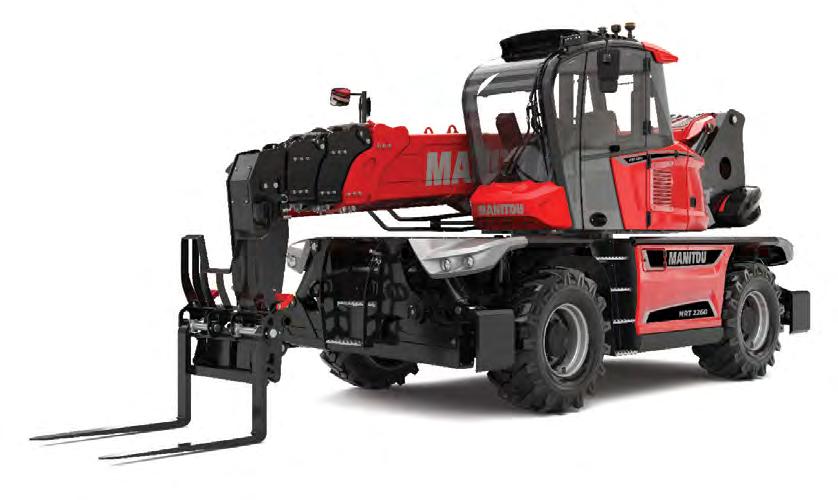
The MRT 2260 is a new model within the VISION+ range of rotating telehandlers from Manitou.
ADVANCED TECHNOLOGY AND NEW DESIGNS FOR THE CAT 815 SOIL COMPACTOR
The new Cat 815 Soil Compactor features technology upgrades to help increase productivity and efficiency, so more area is compacted in less time on large earthworks projects. New machine designs and revised service groupings combine to cut maintenance costs. With all components relocated from the cab roof to lower overall transport height, the redesigned operator’s cab upgrades the steering and climate controls to elevate comfort. The Cat 815 is built for high-speed, high quality soil compaction with its four 39 in (991 mm) wide steel drums. Drum design boasts a chevron pattern to the tamping tips, delivering high ground pressure and compaction, good traction and a smooth ride. A symmetrical tip pattern offers equal compaction effort in both forward and reverse, and the special tamper design reduces material fluffing. Adjustable cleaner bars eliminate material carryover regardless of rolling direction to maximise compaction efficiency.
Technology increases productivity
With the new 815 Soil Compactor, Cat Compact GPS mapping is now offered from the factory to provide visibility to compacted areas as well as cut and fill data. These new technologies allow companies to meet compaction targets quickly, uniformly and in fewer passes, with the 815, saving on fuel and the costs associated with rework. Operators are kept informed of compaction progress with Cat Compaction Control with Machine Drive Power (MDP). This energy-based measurement system correlates compaction with rolling resistance to indicate soil stiffness, improving compaction efficiency. Real-time machine performance and operating data captured by the Vital Information Management System (VIMS) are conveniently monitored on the large, in-cab 3G touchscreen display. Accessed online via the VisionLink interface, Cat Link technology captures operating data such as machine location, hours, fuel consumption, idle time, events and diagnostic codes, to improve fleet management efficiency.
Advancing operator productivity
The compactor’s redesigned cab delivers greater comfort and easier control for higher operator productivity. Upgrades to the single Cat STIC system allow for shorter, faster cycles to reduce operator fatigue and increase efficiency. The STIC system combines steering, gear selection and other functions into a single lever. Only small side-to-side inputs are required to steer the new 815, and gear changes are effortlessly fingertip-controlled. The cab sits on isolation mounts and features a new Premium Plus seat with leather finish, forced air heating and cooling, two-way thigh adjustment, power lumbar and back bolster adjustment, and dynamic end dampening, for total comfort throughout the workday. A flip-up armrest affords easier ingress/egress to the cab. Pressurised to keep debris out, the cab features an automatic climate control system that maintains the operator’s preferred temperature settings. Its sealed design lowers interior sound levels to improve operator comfort. The standard rearview camera is conveniently visible on the in-cab display to improve operator visibility when compacting in reverse.
Lower maintenance costs
The new 815 soil compactor features improved airflow technology to reduce cleaning and maintenance. A new radial air filter delivers three times the life of the previous design, and operators are alerted to airflow blockages, by an electronic air inlet restriction indicator. The compactor’s electronics bay is located inside the updated cab to improve servicing ease in a climatecontrolled environment. Sight gauges for the coolant, transmission oil and hydraulic system provide quick inspection with reduced contamination risk. Grouped hydraulic oil, fuel cooler and condenser service points, along with centralised grease points, help to further minimise maintenance time. Access to emergency shutdown, battery disconnect and jump start are quickly and conveniently obtained from ground level. Heavy-duty main structures are built to be rebuilt, offering multiple life cycles to lower total cost of ownership for the new 815. Heat-treated and direct-hardened, the adjustable cleaner bar tips deliver increased wear life with lower operating costs. The durable tamping tips deliver a long life and are replaceable.
Smooth power
The new Cat 815 Soil Compactor is powered by the fieldproven Cat C7.1 engine designed for maximum fuel economy, reliable performance and increased power density.
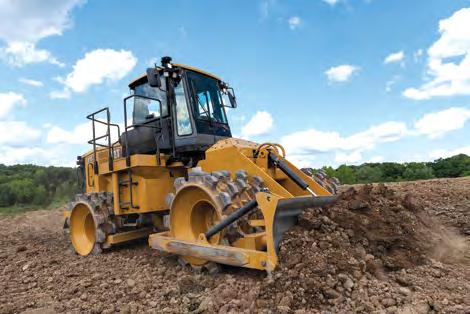
The new Cat 815 Soil Compactor is built for high speed, high quality soil compaction.
IES UPDATE
SUSTAINABILITY THE KEY DRIVER OF CONVERSATIONS
On 14 May 2021, the IES Charles Rudd Distinguished Public Lecture was held at the Singapore University of Technology and Design (SUTD) Auditorium. A hybrid event, it was attended by some 50 guests physically, and viewed online by more than 1,700 participants from Singapore and around the world. Jointly organised with SUTD, the Lecture focused on sustainability and its impact on our future lives. Its aim was to drive greater understanding and action in building a green and liveable home, and highlight the challenges and opportunities in engineering – a key enabler of a sustainable future. The Lecture was also held in commemoration of the UNESCO World Engineering Day for Sustainable Development. Relating to the theme, Minister for Sustainability and the Environment Grace Fu spoke about the effect of climate change on Singapore, the tradeoffs and issues the nation faces in its decarbonisation journey, as well as the solutions Singapore is pursuing to overcome these challenges, in her keynote address. She noted that engineers would play an important role in the journey to achieve the targets set under the Singapore Green Plan 2030. The invited speakers then took the podium to share their insight on sustainability in the local and global context. Each an eminent engineering expert and thought leader in their fields, the speakers were: Prof Lui Pao Chuen, Temasek Defence Professor; Dr Bicky Bhangu, President, South East Asia, Pacific & South
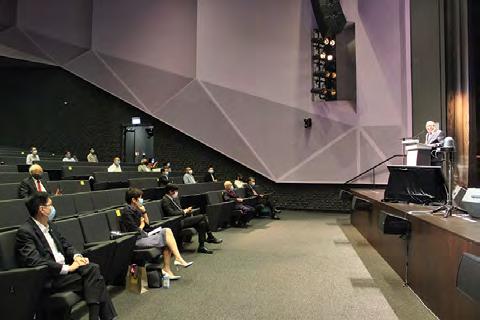
Mr Manohar Khiatani from CapitaLand Group speaks to participants about driving sustainability in the built environment.
Prof Seeram (third from left) leads the rest of the speakers and panellists during the panel discussion. The rest of the panel include (left to right): Mr Benedict Chia, Dr Bicky Bhangu, Prof Lui Pao Chuen, Mr Calvin Chung, and Er. Goh Chee Tiong.

Korea, Rolls-Royce; Mr Benedict Chia, Director (Strategic Issues), National Climate Change Secretariat, Strategy Group, Prime Minister’s Office; Mr Manohar Khiatani, Senior Executive Director, CapitaLand Group; and Prof Seeram Ramakrishna, Chairman of both the NUS Circular Economy Taskforce and the IES Sustainable Manufacturing Technical Committee. Joining the speakers for the panel discussion on sustainability driving the future of engineering, jobs, economy and life were: Mr Calvin Chung, Chief Environmental Officer, JTC Corporation; and Er. Goh Chee Tiong, Chief Engineer/ Deputy Director, Carbon Mitigation Division, NEA. They outlined the progress made in areas such as increasing food production, enhancing energy efficiency, and developing greener transportation, and discussed potential growth areas for individuals, companies, and nations alike. The four-hour webinar concluded with a lively discussion between the panellists and the online audience, whose questions were picked out by Prof Seeram, who moderated the discussion. IES offers its deepest appreciation to SUTD for coorganising the Lecture, as well as to all sponsors and supporting partners for their assistance in ensuring the event was held in a safe, smooth, and sustainable manner.

Wong Yui Cheong conferred the IES Lifetime Engineering Achievement Award 2021
At the Lecture, Ms Grace Fu, who was also the guestof-honour, presented the IES Lifetime Engineering Achievement Award 2021 to Mr Wong Yui Cheong. The award is the highest honour accorded to an engineering leader in recognition of lifetime accomplishments that have made profound impact on the engineering discipline, industry and community and for bringing international honours to Singapore. In an illustrious career spanning over 40 years, Mr Wong has made distinctive contributions to the local built environment as an exceptional design engineer, project manager, consulting engineer, real estate developer and educator. He was involved in several iconic and important buildings in Singapore, such as the DBS Building, Plaza Singapura, Pandan Valley Condominium, and Raffles City complex. He also left his mark on design engineering internationally, through notable projects such as the waterfront landmark structures in Merseyside, England and Malayan Flour Mill in Lumut, Malaysia. After retiring from business in 1999, he took up an adjunct professor role in construction project management, contract administration and risk management for the Master of Science (International Construction Management) programme at NTU. He also made a generous SGD 1 million donation to IES that led to the setting up of the IES-YC Wong Project Management Scholarship Fund to support post-graduate students in carrying out research in project management. Furthermore, he provided engineering consultancy services to the structural design of the original IES building for a token fee of one dollar, and donated SGD 20,000 to the new IES Green Building fund. Mr Wong has also made valuable contributions to IES as a Council Member and Chairman of the Civil and Structural Engineering Technical Committee. “I am very honoured to receive this award. As we move into a new era, global concerns such as climate change and future pandemics are critical issues that will require engineers to solve. It is my hope that the younger generation will join the ranks of engineers to push the boundaries of engineering and create an even greater future for Singapore,” said Mr Wong.
Ms Fu presenting the Lifetime Engineering Achievement Award 2021 to Mr Wong.
(From left) IES President Dr Richard Kwok, Ms Fu, Mr Wong, Immediate Past President and Awards Committee Chairman Prof Yeoh Lean Weng, and Deputy President Dalson Chung take a group photo on stage.
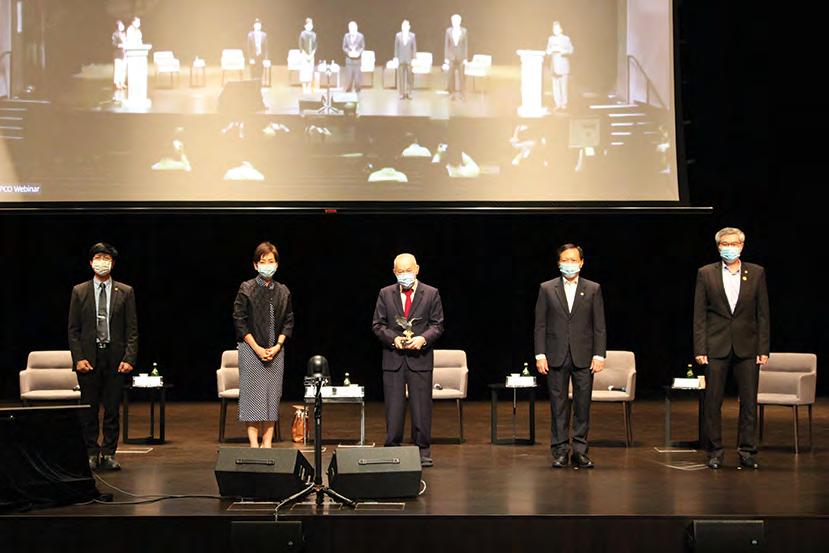
ER. ONG SEE HO
FORMER IES VICE PRESIDENT AND COUNCIL MEMBER
Er. Ong See Ho FIES, FIStructE, who was Vice President of IES from 2011 to 2014 and from 2016 to 2020, passed away peacefully on 10 May 2021. He was 68. A member of IES since 1978, Er. Ong was instrumental in forming the Engineering Accreditation Board (EAB) in 2002, as well as getting it admitted as a full signatory of the Washington Accord in 2006. The EAB, which he chaired until 2018, represents IES as a body to accredit undergraduate engineering degree programmes that are delivered and awarded in Singapore. This allows engineering degrees awarded here to be recognised by other Washington Accord signatories. Er. Ong also helped set up the Chartered Engineer programme in 2013 to provide professional recognition to engineers across all sectors, as a validation of competence and expertise, especially in disciplines that do not require registration as Professional Engineers. He chaired its Board from 2015 to 2020. Apart from these initiatives, Er. Ong helped guide the activities of the various committees that he held leadership positions in. These include the APEC Engineer/IntPE Monitoring Committee, Engineering Expert Panel, IES-ACES Joint Registry Monitoring Committee, Qualification & Membership Committee, and the Smart Nation Cluster. For his significant efforts towards developing the engineering community, he was conferred fellowship in IES and IStructE. He also received the Public Administration Medal (Silver) in 2004 for his contributions to the Building and Construction Authority, and was similarly honoured with the NUS Distinguished Alumni Award in 2012 and Honorary Fellowship in the ASEAN Federation of Engineering Organisations in 2015. His tireless efforts and exemplary service at IES are an inspiration to all. The President, Council and Secretariat are deeply saddened by this news and express their sincere condolences to his family.

ADVERTISERS’ INDEX
IES Chartered Engineer ––––––––––––– Inside Front Cover IES Membership –––––––––––––––––– Inside Back Cover Who’s Who In Engineering, –––––– Outside Back Cover Singapore (3rd Edition)






